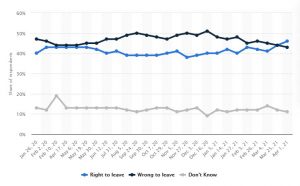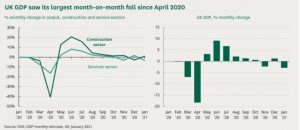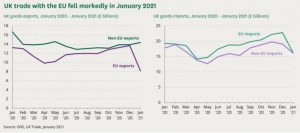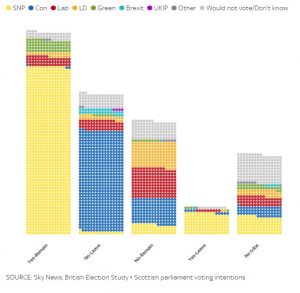Many aspects of life have changed three months since Brexit became a reality and the EU rulebook no longer applies to the UK.
The effects have been felt by both individuals and corporations, but it is difficult to discern this from the overwhelming impact of the pandemic.
As of April 2021, 43% of Britons believed that leaving the European Union was the wrong decision, while 46% believed it was the right one. After multiple pollings in the run-up to the referendum, leave received 51.9% of the votes, but now has 48.1%.

The Immigration Act gained Royal Assent and was signed into law on Wednesday, 11 November 2020.
The UK is limiting immigration with a points-based scheme similar to Australia’s. It entails granting high-skilled employees first preference and barring low-skilled workers from entering. Many EU job seekers may also be asked to leave.
What has changed in terms of immigration to the United Kingdom? People from EU countries had an exclusive right to work in the UK while this country was still a member of the EU. One of the main themes of the leave movement in the 2016 referendum was taking control of immigration.
Prime Minister Boris Johnson has said:
“Today marks the delivery of our promise to the British people to regain control of our borders and consider new arrivals on the basis of the skills they have to offer and the contribution they can make, not where they come from.”
“The passing of this landmark Bill means that for the first time in decades we will have a firm and fair immigration system”, Prime Minister Boris Johnson said.
People from the European Union (EU) have been treated in the same way as nationalities from other countries beginning in 2021.
EU nationals had an exclusive right to work in the UK while it was still a member of the EU. One of the main themes of the leave movement in the 2016 referendum was taking care of immigration. The new work visa scheme will be focused on points.
The points-based scheme in the UK treats EU and non-EU residents similarly, with the aim of attracting people who can contribute to the UK economy. Irish people will continue to come, live, and work in the United Kingdom independently.
As a result of lockdown restrictions, GDP growth between November and December 2020 fell by 2.9%.
This downturn was felt more strongly in the service industry, such as retail, catering, and lodging, which saw productivity fall by 3.5% between December and January due to restrictions imposed on it.
Between December and January, there was also an 8.2% drop in the volume of retail sales.
Construction was one of the sectors that grew in January, with production increasing by 0.9% due to new jobs. The drop in GDP in January was smaller than many analysts had expected, and it was significantly lower than the drop in GDP during the first lockdown. This indicates that the economy has started to adjust to the lockdown restrictions.

Transition time has come to an end and a new age in UK trade has begun.
As a result of the UK’s exit from the EU single market, as well as additional bureaucracy and often unforeseen prices and taxation, goods exports fell by 41% and imports by 29%.
According to a study released by the Federation of Small Businesses in late March, almost a quarter of small UK businesses surveyed said they had temporarily suspended sales to the EU due to post-Brexit regulations.
The total value of UK trade plummeted in January 2021, the first month after the end of the Brexit transition phase, and the value of trade with the EU did so significantly too.

Official UK statistics released in March revealed that UK trade with the EU fell in January as the economy grappled with post-Brexit regulations and the pandemic.
Within the terms of the divorce agreement, trade between the United Kingdom and Northern Ireland has been hampered while trying to maintain a free north-south boundary on the island of Ireland. After the British government arbitrarily extended a grace period on certain food inspections, the EU took legal action against the UK.
Financial Services
Only a few ambiguous agreements on utilities were included in the Brexit agreement, and financial services were left for a different phase.
The UK and the EU have signed a “Memorandum of Understanding” on future relations, as planned, from the end of March. It is hoped that it will assist City of London businesses in regaining access to the EU that they lost as the UK exited the EU single market.
Unemployment
According to the OBR, unemployment will reach 6.5% in the fourth quarter of 2021. Due to the government’s expansion of work support programmes, this is smaller than the November estimate of 7.5%.
Unemployment rates rose marginally to 5.0% from November 2020-January 2021, up from 4.9% the previous quarter. Employment dropped to 75.0% in the third quarter, down from 75.2% the previous quarter, and is now at its joint lowest level since 2017.
How Secession and Brexit Are Influencing the Vote in Scotland in 2021

The Scottish Parliament Election on 6 May could have far-reaching implications for the United Kingdom.
When it comes to voting, people will remember Nicola Sturgeon’s handling of the pandemic. However, if her Scottish National Party (SNP) wins a majority, the pressure on Boris Johnson to allow a second independence referendum will increase.
Since 2014, when Scots voted 55% to 45% not to secede from the rest of the United Kingdom, the nation’s politics has been dominated by not one, but two sovereignty questions: Should Scotland be independent of the United Kingdom? Is it necessary for it to leave the European Union?
These questions are far from resolved for many Scottish voters after two referendums, and this has reshaped the political environment.
According to the Scottish Election Report, electors in Scotland are divided into four tribes based on their positions on secession and Brexit.
The British Election Study completed a poll of 3,223 Scots in December 2019 and observed the same groupings.
Sky News analyzed the data to look at party support among the four tribes and those that did not belong to any of them.
Yes & Remain, No & Leave, No & Remain, Yes & Leave
YES & REMAIN
A third of voters supported independence and wished to stay in the European Union. They voted SNP in large numbers, which is unsurprising considering the party’s pledge to independence and opposition to Brexit.

YES & LEAVE
The SNP also controlled the smallest tribe (5%) of respondents who supported both Brexit and Scottish independence.
NO & LEAVE
A fifth of the respondents said they preferred to remain in the UK but leave the EU. About 75% of them voted Conservative, with the party’s popularity almost doubling in recent years.
NO & REMAIN
A quarter of those polled opposed independence and preferred to stay in the EU. In this tribe, Labour had a slight lead, but it didn’t conquer as its competitors did with other tribes.
NO TRIBE
Since they did not mention a stance on independence or Brexit, 14% of the respondents could not be identified as belonging to a tribe. A third of those polled said they either wouldn’t vote or hadn’t decided who they would vote for. They backed the SNP with 22% of the vote.
The European Union referendum aided the Conservative Party in making significant strides with ‘No-Leavers,’ propelling it to second position for the first time since 2016. The ‘No-Remain’ tribe, which makes up 20% of the electorate, is the most competitive.
All of this shows that, in an electoral structure that makes winning a vote less possible, Nicola Sturgeon could win one, according to recent polls.
If she succeeds, it will be just the second time since the Holyrood elections started in 1999 that a faction has done so. This will also be a remarkable achievement for a party which has been in power for 14 years.

















